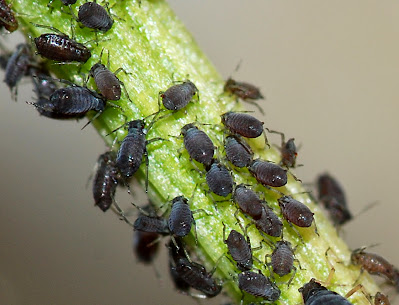Aphids, an Introduction
The aphids are probably best known as "greenfly", "blackfly" and "white fly". They belong to a group of insects known as "bugs" or Hemiptera, the mouth parts of which are modified to form piercing and sucking tubes. The insects obtain their food by sucking plant juices or the blood of other animals. This group of insects has an incomplete metamorphosis, there being no pupal stage but a series of molts in which the nymph gradually becomes a mature adult.
There are over 4000 species and varieties of aphids but the account given below applies in general to those commonly encountered as garden and orchard pests.
Life history. In October the females lay eggs usually on the stems of trees or shrubs. The eggs are black, with thick shells, and can withstand extremes of temperature. It is in the egg form only that aphids pass the winter. In March the eggs hatch out into wingless female nymphs which are similar to the adults, with three pairs of legs, compound eyes, antennae, etc. There is no larval or pupal stage comparable to those of the butterfly, but with successive molts and continuous growth, the nymphs become mature females. No males are hatched at all.
The daughters grow quickly and have offspring by parthenogenesis. Some of these develop wings that grow larger at each molt. These winged daughters fly off to herbaceous plants such as a rose or bean plant. The aphids are not strong flyers but tend to be carried by chance air currents rather than make direct flights.
In October the first males appear. They have wings and fly to a tree. Winged females fly to the same tree and there give birth to wingless daughters. The males mate with these when mature, and the wingless females subsequently lay eggs on the twigs of the tree. The eggs remain dormant until the following spring when the tree buds begin to sprout.
Want to learn more about Regenerative Landscape Design? Join The Bloom Room!
The Bloom Room is designed to create a space for more in-depth learning, for sharing projects and ideas, for seeking advice and discovering opportunities.
Ultimately, it aims to build a more intimate, interactive, and actionable relationship between members, a way for the Bloom Room community to support each other’s projects and learning journeys, and to encourage and facilitate the design, build, and management of more regenerative landscapes across our planet.
What you can expect as a member of the Bloom Room
As a member of the Bloom Room you can expect;
Access to an interactive forum where you can ask questions, direct what type of content you would like to see as well as share your own content and projects.
Monthly live session featuring general Q&A and tutorials on design software for creating and presenting polycultures.
Full Access to all of the content on Substack
A 500 EUR discount on all of our online courses
Future opportunities to join our Global Regenerative Landscape Design and Consultancy Service, with potential roles for those with the will and skill to join our design team.
An opportunity to take part in the group ownership of a Regenerative Landscape. You will find more details on that here.
Become a paid subscriber to our Substack to join. The annual subscription is currently $70 and the monthly subscription is $7 (monthly subscription excludes discounts for products and services) . You can join here, we look forward to meeting you!
Feeding habits. An aphid feeds by inserting its proboscis, stylet or straw-like mouthpart into the phloem or inner cells of a plant.
- Natural predators: Many insects and other animals feed on aphids, including ladybugs, lacewings, and hoverflies. Encouraging these natural predators to live in your garden can help to control aphid populations.
- Water: A strong blast of water from a hose can knock aphids off of plants. This method is best for small infestations and should be repeated every few days.
- Soap and water: Mixing a small amount of dish soap with water in a spray bottle can create a solution that can kill aphids on contact.
- Neem oil: Neem oil is a natural insecticide that can be effective at controlling aphids. It should be applied according to the instructions on the product label. It's worth noting that natural insecticides will still cause harm to other organisms and are best suited to use on house plants or greenhouse plants where natural predators will unlikely be present.
Support Our Project
If you appreciate the work we are doing you can show your support in several ways.
Become a member of the Bloom Room. A $70 annual or $7 per month subscription to our Substack provides you with access to live sessions, design tutorials, a members forum and more, see details here.
Make a purchase of plants or seeds from our Nursery or Online Store
Joining us for one of our Practical Courses or Online Courses
Comment, like, and share our content on social media.
If you appreciate the work we are doing you can show your support in several ways.
Become a member of the Bloom Room. A $70 annual or $7 per month subscription to our Substack provides you with access to live sessions, design tutorials, a members forum and more, see details here.
Make a purchase of plants or seeds from our Nursery or Online Store
Joining us for one of our Practical Courses or Online Courses
Comment, like, and share our content on social media.











